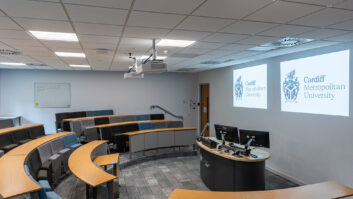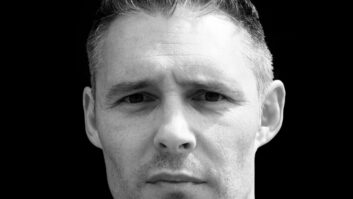 This spring, I received a phone call from the local medical centre’s hearing department. They were calling to set up an appointment to personalise the settings in my new (and first pair) of hearing aids. They politely enquired if I was ready and willing to start using my new hearing aids, and I passionately responded, “Yes! I am more than ready”.
This spring, I received a phone call from the local medical centre’s hearing department. They were calling to set up an appointment to personalise the settings in my new (and first pair) of hearing aids. They politely enquired if I was ready and willing to start using my new hearing aids, and I passionately responded, “Yes! I am more than ready”.
Over the last ten years, I have had my hearing tested regularly. I have damaged hearing with a distinct dip in the 3-5 kHz frequency, speech frequency. I often have problems hearing what is said. I also experience tinnitus frequencies in the spectrum between 8 and 10 kHz. The ringing is increasing, and if you have tinnitus, you know just how annoying it is.
SMART SPARK
I am an educated electrician, and I have had many part-time and full-time sound engineering jobs since age 16, including when I was 18 and started a PA rental company with a friend and my girlfriend at the time. I worked full time in the industrial plants in Odda, Norway as an electrician and ran the PA rental company in the evenings and on weekends. Later, I worked professionally as a sound engineer and, at one point, was the managing director for a professional PA rental company. I am the head of one of two installation departments for B Mikklesen AS. We mainly do IT infrastructure and AV systems, among other things, and deliver turn-key integrated installations in various markets.
In my job as an electrician, there was a high focus on hearing protection, but it was not well enforced. As a young and inexperienced apprentice, I often spent a whole day with a percussion drill and 50mm crown drill without hearing protection. I would hear ‘ringing’ in my ears long after the workday had ended.
I have often experienced the same ringing after a wonderful day in the mountains with beautiful weather, lots of grouse in the terrain, and no hearing protection. I hunt small game with shotguns and reindeer with hunting rifles. The cartridge belt around my waist becomes empty, and my backpack gets heavier and heavier with wild game. The ears hiss and ring, “but the experience makes it worth it!” Or does it?
I am old enough that I remember when the portable cassette player, the Walkman, first came to market. We were certainly not concerned about safe listening levels back then. When we cranked up the volume, we were not thinking about how it might harm our hearing. Gradually, better and better headsets and systems appeared that play right into the ear canal to reproduce the sound image and thus enhance the sound experience. We never thought about the fact that the ears are not made for it. Today, smartphone users can change the maximum headphone volume for music and videos in their device’s settings to protect their hearing.
I am a bassist and vocalist in various bands. If you’ve ever played in a band or been to a gig or rehearsal when everything gets too loud and you do not hear anything, you know it can be easy to get carried away by the atmosphere and groove. The volume goes up, and the mind goes out!
HEARING BLUES
Once, I introduced myself to an American blues artist as his gig’s front-of-house engineer, and his response was, “Ahhh! So YOU are my sound victim!” Because that’s exactly what you get in smaller places where you want to make everyone happy. Sound technicians often run into musicians demanding high sound pressure level (SPL) on stage, organisers that do not understand that all clubs cannot host all artists, gigs in places with terrible acoustics, limited budgets for the stage production, and the lack of access to the right tool for the job. These challenges, along with others, often make it almost impossible to mix the gig on healthy listening levels. I have been in that situation so many times!
I still take some jobs as a sound technician but am very particular and only accept jobs that do not involve high sound pressures and too high a load on what I have left of my hearing.
At home, my family has experienced my hearing loss more than I have. If there is too much background noise, like a vacuum or one of the kids playing music, I can’t hear what is said. Sometimes it comes in handy. I also have ‘selective hearing’ when asked to do something I do not have the desire or energy to do. My wife jokes that she turns on the vacuum cleaner if she does not want me to hear something. Joking aside, it is a burden for my family, colleagues, and for myself that my hearing fails. It can affect my mood and sense of humour.
Research now also points to a clear connection between hearing loss and the development of dementia. This is not good news for those of us who have not taken the necessary precautions to preserve and protect our hearing. It has been estimated that over one million Norwegians are affected by hearing loss. I am one of them.
PARADISE FOUND
In May, I received my small Phonak Paradise hearing aid devices. With today’s advanced technology, the devices automatically change listening modes based on the amount of background noise to ensure maximum speech intelligibility. They are rechargeable, so I only charge them at night, allowing me to use them all day. The transducers are located inside the ear canal, and all electronics with microphones hang behind the ears. Overall, they are virtually invisible to anyone who does not know that I wear them. I use the hearing aids as a hands-free listening device when using my smartphone, although it can appear a bit strange when I’m talking to myself without my phone up to my ear. I can also stream music and other content from my mobile phone via Bluetooth.
I have used my hearing aids all day, every day since I got them, and they work really well! When I don’t wear them, it feels like I have cotton balls in my ears… and the tinnitus tones become far more prominent. I have an advantage in adapting the equaliser curves in the devices from my background in pro audio. I can convey to the audiologist what I hear so that these curves are optimal beyond the system’s automatic settings. It is a process of getting used to wearing hearing aids, but this has gone surprisingly well for me.
In the tuning session, I asked the audiologist if the hearing aids had T-coils for induction loop. She answered, “no, that significantly increases the size of hearing aids.” I asked if T-coil was a discontinued technology, but before she answered, she looked at me very curiously, a little uncertain on how to respond. As she spoke about it, it was clear that induction loop interest groups have a dominant position defending this old technology as the only working solution, ignoring the newer technology developments bringing out new and better-sounding solutions.
She confirmed that for “new and younger” users, they have chosen to stop providing T-coil hearing aids. I took the opportunity to explain Listen Technologies’ audio over Wi-Fi solution, Listen EVERYWHERE. She listened attentively and was very interested in this fairly new assistive listening technology. As a new hearing aid user, I could actually test Listen EVERYWHERE for myself now.
In my job as an audio integrator, Listen EVERYWHERE is a natural part of the systems I design and sell. This is the future of assistive listening solutions, and now I can see the importance of implementing such systems.
As we speak, we are in the process of installing a Listen EVERYWHERE assistive listening solution in the local authorities auditorium (Kommunestyre salen) in Ullensvang municipal. The secretary for the assembly is using the same type of hearing aids as I do. She is 100% dependent on her hearing aids, so she is eager to see the installation completed and to be able to hear what is said in the meetings much more clearly.
I can’t change the past and undo the damage I’ve done to my hearing, but I can take steps to prevent further damage. I can also share my story to hopefully inspire others to be more aware and take action to avoid damaging their hearing and hopefully avoid noise-induced hearing loss.
Find out more about assistive listening in our dedicated feature.







